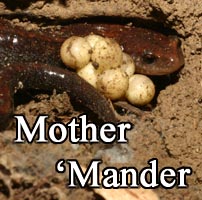| |
Wood frog tadpoles change their development and behavior in ways that improve their survival across variable environments. Tail shape is one example of this developmental flexibility. When faced with predatory insects, tadpoles develop deep tails that improve their ability to survive attacks. But when predators are missing, tadpoles develop smaller tails, allowing them to conserve energy for growth. The pictures above illustrate this. The top tadpole was raised in an environment without predators, and so developed a shallow tail. The bottom tadpole was raised in an environment with predators, and so developed a deep tail.
|
|











